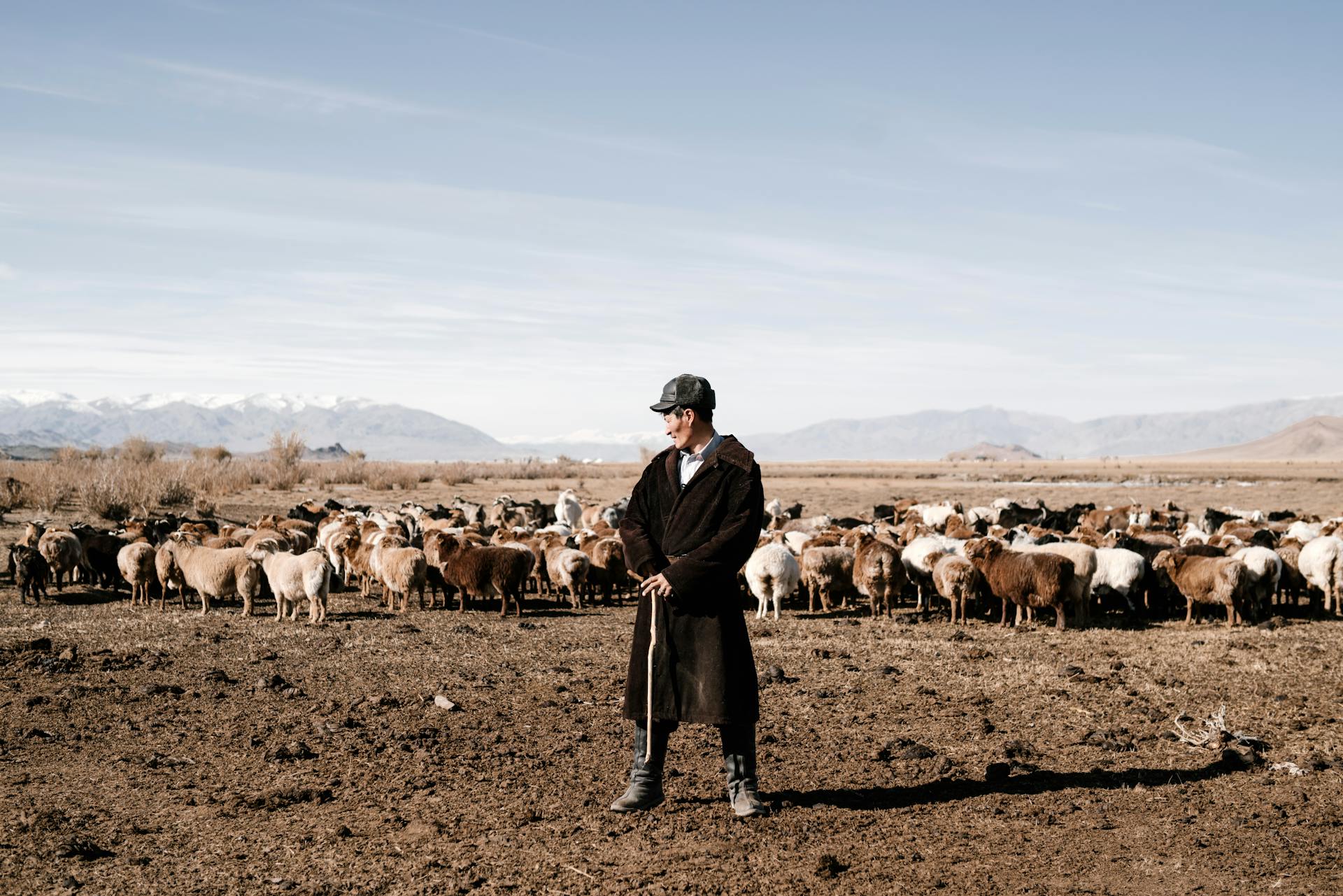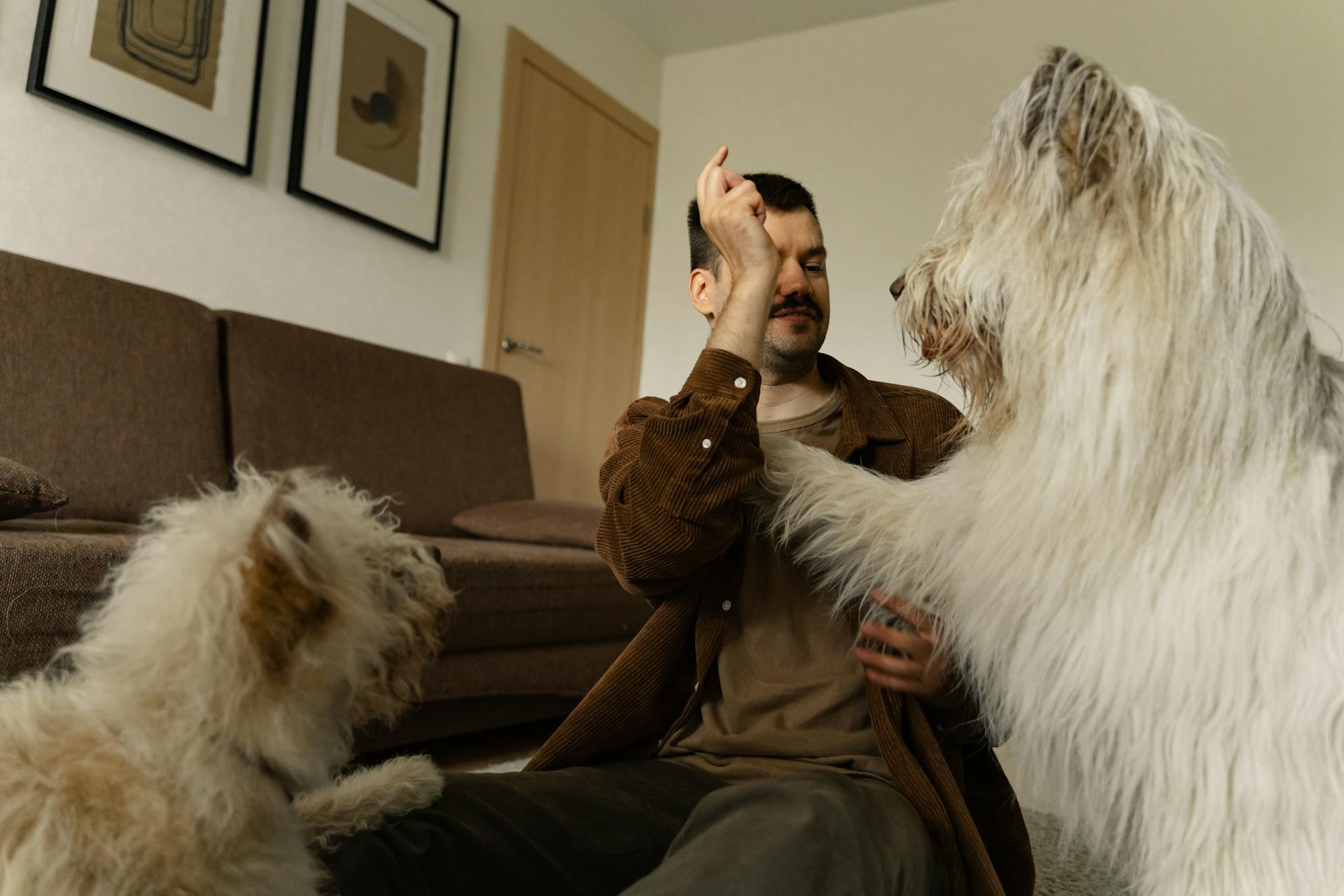
Resource guarding dog to dog can be a challenging issue to tackle, but understanding the underlying causes is key to prevention and resolution.
According to research, dogs that guard resources are often motivated by a desire to protect their food, toys, or space from other dogs.
Resource guarding can be triggered by a variety of factors, including past experiences, genetics, and environmental influences.
In a study on canine resource guarding, researchers found that dogs that were fed in close proximity to other dogs were more likely to develop resource guarding behaviors.
A common misconception is that resource guarding is a sign of aggression, but in reality, it's often a defensive behavior.
What is Resource Guarding?
Resource guarding is a natural dog behavior that's hardwired into animal nature to protect essential resources like food, water, and a safe space. It's a behavior that discourages others from taking or getting too close to an object or valued area in the dog's possession.
Resource guarding can manifest in various ways, from a simple look to a slight baring of the teeth, and it's not always accompanied by growling, lunging, biting, or fighting. Patricia McConnell defines it well, as "any behavior that discourages another to take, or get too close to, an object or valued area in the dog's possession."
This behavior is not unique to dogs; humans also exhibit resource guarding instincts. Access to resources is essential to survival, and it's natural for animals to protect what they believe they need to survive.
Causes and Prevention
Resource guarding dog to dog is a serious issue that can be prevented with the right approach. Prevention is always easier than treatment.
Preventing resource guarding requires setting your puppy or new dog up for success, which is exactly what the process of preventing resource guarding from developing in puppies entails.
To do this, you can follow the tips outlined in the article "How to Prevent Resource Guarding" which includes proactive training exercises.
What Causes Guarding in Dogs?
Resource guarding in dogs is often triggered by limited resources, such as when there's only one chew but two dogs. This can lead to an increase in guarding behaviors.
Dogs may also gauge whether a particular resource is worth fighting over, taking into account its value. Many dogs will communicate with each other using body language and vocalizations to express their desire for the thing the other dog has.
Resource guarding can become a problem in multi-dog households or environments where the dogs resort to fighting over their resources. If left unmanaged, this can escalate into true aggression.
Ritualized aggression, a normal part of dog communication, can indicate underlying stress and negative emotional associations. In some cases, it may be a precursor to true aggression.
A fresh viewpoint: Dog Training Resources
Preventing Guarding in Puppies
Preventing resource guarding in puppies is easier than treating it, so set your puppy up for success with proactive training exercises.
The process of preventing resource guarding isn't much different from the tips outlined above.
You can prevent resource guarding by teaching your puppy to share, take turns, and leave items alone when asked.
It's crucial to establish a routine and manage your puppy's environment to prevent conflicts over resources.
Resource guarding often develops in puppies due to fear or anxiety, so it's essential to address these underlying issues through training and socialization.
Most dogs will gauge whether a particular resource is worth fighting over, but some may not, so it's essential to teach your puppy to communicate effectively and respect others' boundaries.
If you have a multi-dog household, you might see the ebb and flow of resource guarding "conversations" your dogs have, which is called ritualized aggression.
True aggression is an expensive behavior for dogs to engage in, and most dogs want to avoid it if possible, so they may posture and act "tough" but not back it up with true aggressive engagement.
Preventing resource guarding in puppies requires patience, consistency, and positive reinforcement training.
By teaching your puppy to share and respect others' boundaries, you can prevent resource guarding from developing in the first place.
Recommended read: Stop Dog on Dog Aggression
Guarding Between Dogs
Dogs will guard resources from each other, or even other pets in the home, like cats, when resources are limited or when a new pet joins the household.
This behavior is called dog-directed resource guarding and can occur over a variety of items, including food bowls, high-value chews, and toys.
Many dogs will communicate with each other using body language and vocalizations to express their desire for the thing the other dog has or to tell the other to leave them alone.
In multi-dog households, you might see the ebb and flow of resource guarding "conversations" they have, which is called ritualized aggression.
True aggression is an expensive behavior for dogs to engage in, as it risks injury or worse, and most dogs want to avoid it if possible.
Some dogs, like my own Sookie, are possessive of certain items but are conflict-averse and will give low-level signals to the other dog, saying "This is mine, leave me alone."
Related reading: Food Alternatives for Dogs
Here are some signs of resource guarding in dogs, including:
- Stiffening their body over an item
- A hard stare
- “Whale eye” (when dogs show the whites of their eyes)
- Lifting their lips
- Low growling
- Baring their teeth
If your dogs are getting into fights over resources, it's essential to manage the situation to prevent conflicts from escalating.
Training and Management
Preventing resource guarding is always easier than treatment, so set your dog up for success by practicing proactive training exercises.
You can also teach your dog to go to a designated spot, such as a "place" or "station", where they won't be disturbed, helping to prevent unwanted guarding behaviors.
Having a go to place cue on command means you don't need to physically guide your dog to a different space, keeping you safe and reducing the risk of resource guarding incidents.
Signs of Guarding
Resource guarding in dogs can be a serious issue, and it's essential to recognize the signs early on. Growling, lunging, and air snapping are the most obvious signs, but these behaviors often appear after more subtle signs have been present for a while.
Freezing, eating faster, and taking an item and moving away are some of the less intense signs of resource guarding. A dog may also display a braced body position over the item or subtly shift its body weight to block the item.
Some dogs may show a hard stare, side eye staring, or track the person or pet approaching. Raising lips and baring teeth are also common signs. Ears pinned flat against the head can be a sign of resource guarding in some dogs.
Here are some common signs of resource guarding in dogs:
- Growling
- Lunging and Air Snapping
- Chasing you or another animal away
- Biting
- Freezing
- Eating faster
- Taking an item and moving away
- Braced body position over the item
- Subtle shifting of body weight to "block" the item
- Side eye staring or tracking of the person or pet approaching
- Raising lips and baring teeth
- Ears pinned flat against the head
- Hard stare
It's essential to recognize these signs early on to prevent the behavior from escalating into more serious issues.
Don't Punish Growth
Punishing a growling dog can actually make them more likely to bite. You can punish away a growl, but you'll just be making a dog more likely to skip the growl and go straight for a bite.
Check this out: Dog Bite

Ignoring warnings, like growls, will escalate behavioral responses in both humans and dogs. This means you'll be taking away important warning signs that your dog needs to communicate with you.
A dog growl is not a challenge to you or the dog being mean or bad. They're literally trying to communicate with you without escalating to a bite.
Always listen to a growl by stopping your approach, taking a step back, and evaluating the situation.
Teach Your Dog
Preventing resource guarding is much easier than treating it, so it's great that you're thinking ahead. Set your puppy or new dog up for success with proactive training exercises.
Don't play with their food and chews, as this can actually create resource guarding behavior. Sticking your hand in their food bowl while they're eating or taking away their chew toy can teach them that when you reach for something, they'll lose it.
Training a reliable recall with your dog is useful for preventing resource guarding behavior. You can call them away from something that they have rather than approaching them and trying to grab it.
Teaching your dog to go to place can also help prevent resource guarding. This means asking them to move to a designated spot where they will not be disturbed, keeping you safe and helping to prevent unwanted guarding behaviors.
Related Topics
If you're dealing with a resource guarding dog, it's essential to understand the concept of "resource" in this context. A resource can be anything from food to toys to attention.
Resource guarding is a common issue in multi-dog households, where dogs may feel the need to defend their resources from other dogs.
Dogs that resource guard often exhibit possessive behavior, such as growling, snapping, or even attacking when approached by another dog.
Understanding the underlying reasons for resource guarding, such as fear, anxiety, or past trauma, is crucial to addressing the issue.
Some dogs may have learned to resource guard by observing other dogs in the household, while others may have developed this behavior due to a lack of socialization.
In either case, patience and consistency are key when working with a resource guarding dog.
A unique perspective: Why Do Dogs Attack When They Sense Fear
Frequently Asked Questions
How do I stop resource guarding immediately?
To stop resource guarding immediately, provide your dog with sufficient and equitable resources, and teach "give" and "leave it" cues by pairing the action with a reward. This helps your dog understand that giving up resources is a positive experience.
How do you desensitize resource guarding?
To desensitize resource guarding, start by standing outside the dog's reaction zone and gradually increase proximity while offering high-quality treats. This gentle approach helps the dog associate your presence with positive outcomes, reducing resource guarding behavior.
Will a puppy grow out of resource guarding?
Puppies do not outgrow resource guarding, but rather develop it over time if not addressed. Early training and prevention are crucial to helping your dog feel comfortable sharing resources.
Sources
- https://www.patriciamcconnell.com/theotherendoftheleash/resource-guarding-dog-to-dog
- https://www.preventivevet.com/dogs/resource-guarding-in-dogs
- https://www.akc.org/expert-advice/training/resource-guarding-in-dogs/
- https://www.doggoneproblems.com/loumi-stop-resource-guarding/
- https://school.grishastewart.com/courses/resource-guarding
Featured Images: pexels.com


